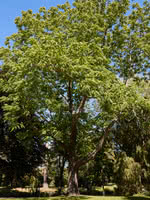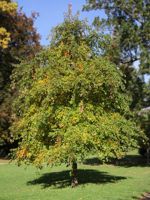Mon-Fri 9am - 5pm Mountain time
Black Walnut vs Black Gum
Juglans nigra
Nyssa sylvatica
NOT AVAILABLE THIS SEASON - MIGHT RETURN
NOT AVAILABLE THIS SEASON - MIGHT RETURN
The Black Walnut is a slow growing, large, straight-stemmed tree with an open crown. It produces dense, very hard, edible nuts.
Black Walnut has a deeply-furrowed, black bark. Its leaves are about 1 foot long, composed of 15 - 23 slightly stalked leaflets on a moderately stout stock which provide good dappled shade.
Despite being highly valued for its edible nuts and its shade tree aesthetics, it is rare to see this tree on the prairies.
Note: Black Walnut's roots produce a substance named juglone that is toxic to some other plants. Consider this when choosing where you plant a black walnut, as you will not be able to grow tomato, potato, cabbage, eggplant, blueberry, azalea, rhododendron, lilac, red pine and apple in the surrounding area.
Note: Plant this tree once. It will not respond well to transplanting.
Note: Although self-pollinating, planting two trees significantly improves nut production.
A top CO2 absorbing species. Experts think this tree may help climate change more than others.
Black Gum is a slow-growing ornamental shade tree with a dense pyramidal shape. The foliage is dark green in the summer, and transitions to bright fall colours which include red, orange, purple, and gold. It is commonly used as an ornamental tree in parks and large gardens as a specimen or shade tree.
The small greenish white flowers provide nectar for bees and black tupelo honey is a sought after flavour. The small dark blue fruits which ripen in late summer will attract birds and other animals to your yard. The fruits are edible, but very sour, and are primarily used for pies, flavouring, and drinks. Plant the Black Gum where it will live long-term, as it has a large taproot and does not transplant well.

